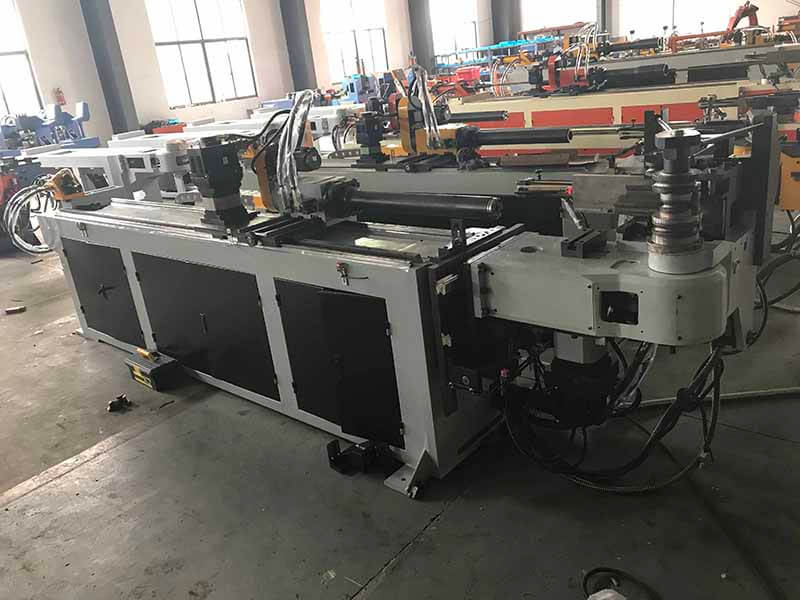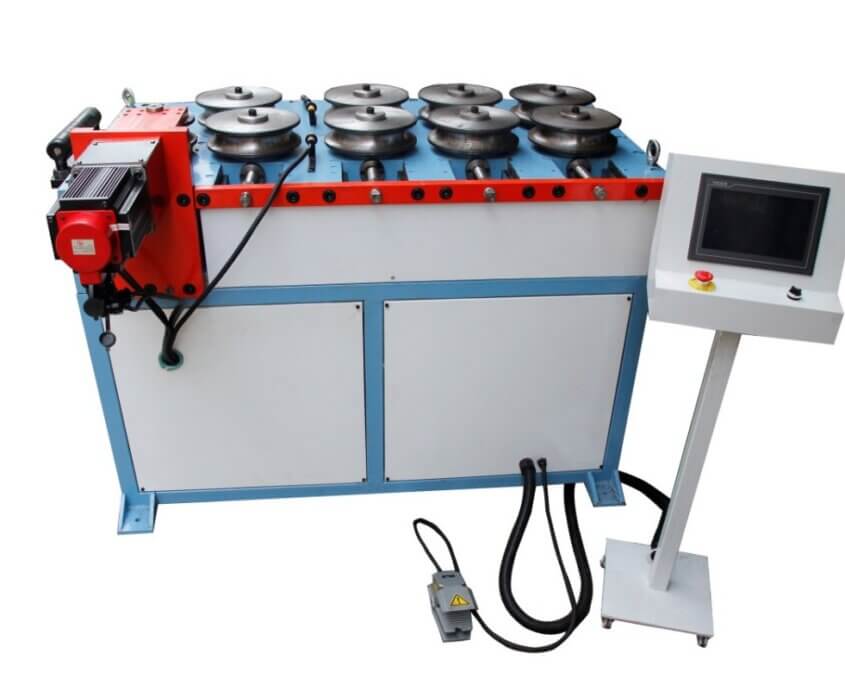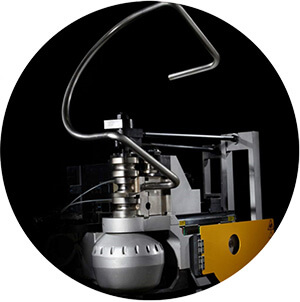Difference Between CNC Tube Bending Machine and Roll Bender
About CNC Tube Bending Machine
Main Types of CNC Tube Bending Machine
Types of Tubes That a CNC Tube Bending Machine Can Bend
Main Components of CNC Tube Bending Machine
Types of Tubes That a Roll Bender Can Bend
Main Components of Roll Benders
What Materials Can Be Bent on CNC Tube Bending Machine and Roll Bender?

CNC tube bending machines and roll benders are the two most widely used types of bending machines in industrial tube bending. Both are suitable for mass production of tubes in various shapes and are widely used in industries such as construction, agriculture, automotive, aviation, furniture, and petroleum. But do you know in which situations a CNC tube bending machine should be used and in which situations a roll bender should be used? What are the differences between them?
About CNC Tube Bending Machine
The tube bending shape is determined by the bending die that installed on the tube bending machine. The larger the CLR, the easier the tube bending process. The smaller the CLR, the more difficult the tube bending process. Generally, the CLR will not be less than 1.5D (D means tube outer diameter).
The most challenging aspect of bending metal tubes is preventing deformation. Deformation during bending typically occurs only in the bent area, especially on the outer and inner walls of the tube, where it is most noticeable. When the tube is bent, the outer wall is in a state of tension, while the inner wall at the bend is in a state of compression. This tensile stress causes the outer wall to thin and elongate, while the compressive stress causes the inner wall to thicken and shorten. In such cases, if the bending machine parameters are not properly set according to the specific material, various types of deformation can easily occur.
To improve the tube bending quality, you have to pay attention to:
- “Wall Factor” and “D” of Bend
- Material elongation
- Material springback
- Overall structure
You may interested in:
Main Types of CNC Tube Bending Machine
A CNC tube bending machine is sophisticated equipment designed to bend tubes and pipes with high precision and repeatability. There are three subcategories of this type of equipment: CNC Hydraulic Tube Bending Machine, CNC Electric Tube Bending Machine, and CNC Hybrid Electric-Hydraulic Tube Bending Machine. So, what’s the difference between them?
CNC Hydraulic Tube Bending Machine
- Driving System: The hydraulic system provides bending force.
- Control System: The CNC system precisely controls the bending angle, bending radius, and position.
- Features: Suitable for processing large diameter and thick wall pipes, providing greater bending force and high precision.
- Application: Widely used in industries that require large torque and high precision, such as shipbuilding, construction, petrochemical, etc.
CNC Electric Tube Bending Machine
- Drive System: An electric servo motor provides the driving force.
- Control System: The CNC system precisely controls the bending process to achieve high-precision and complex-shaped pipe bending.
- Features: Suitable for processing thinner pipes and complex bending tasks, with high precision and high efficiency.
- Application: Commonly used in industries that require high-precision and complex-shaped pipe bending, such as automobile manufacturing, aerospace, and furniture manufacturing.
CNC Hybrid Electric-Hydraulic Tube Bending Machine
- Drive System: It combines a hydraulic system and an electric servo motor. The hydraulic system provides a large bending force, and the electric servo motor provides high-precision control.
- Control System: The CNC system precisely controls the bending process and combines the advantages of both hydraulic and electric systems.
- Features: ① Multiple Drives: The hydraulic system provides strong torque, suitable for bending large diameter and thick wall pipes; the electric servo motor provides precise control, suitable for complex bending tasks. ② High Efficiency and High Precision: Combining the strong torque of the hydraulic system and the high precision control of the electric system, it achieves the best balance of efficiency and precision. ③ Strong Flexibility: It can handle pipes of various thicknesses and diameters, suitable for bending tasks of various complex shapes.
- Application: Suitable for industries that need to meet both large torque and high precision requirements, such as automobile manufacturing, aerospace, shipbuilding, construction, and petrochemical, etc.
As you can see, the biggest difference between the three types of CNC tube bending machine is the driving system. You can consult with our engineer to see which type fits your needs.
Types of Tubes That a CNC Tube Bending Machine Can Bend
TubeBenderN is a professional manufacturer of CNC tube bending machines in China, we can produce machine bending capacity from φ10mm to φ219mm, you can customize your ideal machine from us!
- Round Tube
- Square Tube
- Rectangular Tube
- Solid Bar
- Many Other Section Bars
Main Components of CNC Tube Bending Machine
- Control System: This is the brain of the machine, and controls the precise movement of the bending process. This system can allow the storage of multiple bending programs for different parts.
- Bending Die: The bending die determines the radius of the bend, The CNC machine can change the die automatically if you have a different bending radius.
- Clamping System: The clamping system can hold the tube firmly in place during bending and prevent slippage.
- Pressure Die: Works in conjunction with the bending die to apply pressure on the tube and help achieve the desired bend angle without deformation.
- Wiper Die: This mold is mainly used to prevent the inner wall of the tube from wrinkling.
- Mandrel: Used to insert into the tube to prevent collapse or wrinkling during bending.

About Roll Bender
Roll bending is another technique of tube forming, suitable for bending a large bending radius, at least 5 times the cross-section, such bending radius can be achieved by roll bender.
The roll bender is normally designed with 3 rollers, 5 rollers, 7 rollers, or 9 rollers to achieve different bending shapes. Generally, roll bending is simpler than CNC tube bending.
The roll bending process can produce different bending radii on the same tube. However, the disadvantage of using the roll bender to bend the tube is you have to leave additional material at two ends of the tube, this will increase your tube material cost.
Types of Roll Benders
The roll benders can be installed with different amounts of bending rollers, this depends on specific bending requests. As you can see on the market, there are three main types.
Manual Roll Bender
- Operated by hand, usually with a lever or a crank.
- Suitable for small projects and thinner materials.
- The manual type usually has 3 rollers.
- Most manual roll bender’s top roller is manually adjustable to change the bend radius.
Hydraulic Roller Bender
- Uses hydraulic power to drive the rollers and apply bending force.
- Used to bend thicker and stronger materials than manual benders.
- Hydraulic systems provide smooth and controlled bending operations.
- Each roller can be adjustable tube bending design.
Electric Roll Bender
- Powered by an electric motor, allowing for continuous and consistent bending.
- Generally equipped with digital controls and programmable settings for precise and repeatable bends.
- Some models may include CNC capabilities for complex bending tasks.
Types of Tubes That a Roll Bender Can Bend
TubeBenderN is a manufacturer of roll benders in China, we produce the machine that is able to bend the maximum tube diameter to φ60mm, if you looking for other sizes, we can also customize them for you, talk with our engineer Now!
- Round Tube
- Square Tube
- Rectangular Tube
- Various Metal Profiles
Main Components of Roll Benders
Any kind of tube bending machine will have its basic configuration, such as a driving system, and control system, the main component of a roll bender is its bending rollers, which are different from other bending machines. They are designed according to different tube bending shapes, tube bending materials, and tube bending sizes.
What Materials Can Be Bent on CNC Tube Bending Machine and Roll Bender?
- Iron Tube/Solid Bar
- Carbon Steel Tube/Solid Bar
- Stainless Steel Tube
- Aluminum Tube/Bar
- Copper Tube/Bar
- Brass Tube/Bar
- Titanium Tube
Difference Between CNC Tube Bending and Roll Bending
As we can see above, the biggest difference between a CNC tube bending machine and a roll bender is the tube bending radius. CNC tube bender is used to bend tight bending radius while roll bender is used to bend large bending radius.
The Innovation of Tube Bending Machine
In many cases, the complete tube bending structure needs to be bent both on a CNC tube bending machine and a roll bender, this means when you need to bend such a project, you need to buy at least 2 types of bending machines. But, after technological innovation, now when we need to bend both tight bending radius and large bending radius, we can use only one bending machine, that is our CNC tube bending machine with roll push bending function.
With the push bending function, you can get whatever bending radius you want on the same tube.
Looking for a proper tube bending machine for your production? Contact TubeBenderN to get the solution Today!
You may also interested in:

Denis Lau
Denis Lau has 20 years of work experience in the metal processing industry. His major in university was mechanical engineering, and after graduation, he started from the bottom of the workshop, gaining extensive hands-on professional experience and the ability to tackle challenges from various industries.


